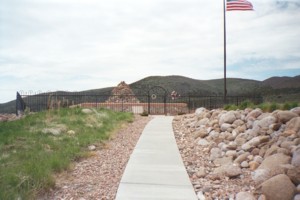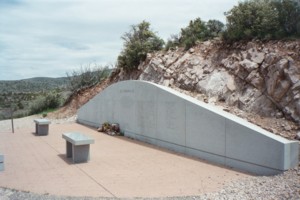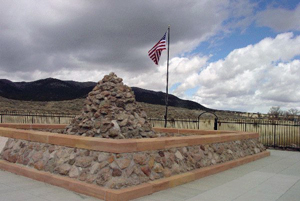This article may include affiliate links. If you click a link and make a purchase, Utah Outdoor Activities may receive a small commission at no extra cost to you. We only recommend products or services we personally use. FTC Affiliate Disclosure.

In April 1857 a California-bound wagon train estimated at 40 wagons, 120 to 150 men, women, and children, and as many as 900 head of beef cattle, in addition to draft and riding animals, assembled near the Crooked Creek, approximately four miles south of present-day Harrison, Arkansas. Most of these emigrants were from northwestern Arkansas and were families, relatives, friends, and neighbors.
Also included in the group may have been some from Missouri, Illinois, Ohio, Tennessee, and northeastern Texas. When they began their journey, their wagon train was identified by some as the Baker train. En route it was known as the Perkins train; in Utah it became known as the Fancher train. However, there were probably individuals and perhaps elements of other wagon trains that joined the Fancher train along the way. The emigrants arrived in Salt Lake City on or about 10 August--a most crucial stop. There they had to refurbish their equipment, refresh themselves and their stock, and replenish their supplies. They also had to decide whether to take the shorter, cooler northern route or the longer, warmer southern route to California. The lateness of the season was the determining factor. They started on the northern route and then retraced their steps to take the southern route.
Their arrival in Utah could not have been at a more critical time. The once friendly Mormons, usually eager to trade agricultural commodities for manufactured goods, were now hostile and reluctant to trade. War hysteria permeated the area. President Buchanan had secretly dispatched an expedition to Utah to suppress what he believed was a rebellion. Governor Brigham Young subsequently issued a proclamation of martial law on 5 August (reissued on 15 September) which, among other things, forbade people from traveling through the territory without a pass. The citizens of Utah were discouraged from selling food to immigrants, especially for animal use.
The territorial militia (affectionately, the Nauvoo Legion), which included every able-bodied man between the ages of eighteen and forty-five, was on full alert. Staff officers, who were also church and civic officials, were dispatched to every settlement under their command to explain and enforce militia decisions. George A. Smith, who commanded all of the southern militia units, arrived in Parowan on 8 August and began the task of preparing the people psychologically, militarily, and materially for war. The units of the Tenth Regiment of the territorial militia were mustered and drilled, and the impending battle plan was explained. Smith, an effective orator and founder of Iron and Washington counties, made several impassioned speeches and apparently accomplished his purpose. The people were convinced that they were in a state of war and were ready to take action.

As the Fancher train moved south without a pass from the Mormons, contact with the local settlers became more abrasive. Stories of both fact and fancy were embellished with each telling. By the time the wagon train reached Cedar City, reports of gross misconduct were believed. The old troubles in Missouri and Illinois were rehashed. The murder of beloved apostle Parley P. Pratt in May of that year in northwest Arkansas was also remembered.
Several meetings were held in Cedar City and Parowan to determine how the "War Orders" should be implemented. The militia decided that the Fancher train should be eliminated. Cooler heads prevailed temporarily and an express rider was sent to Salt Lake City to solicit Brigham Young's advice. The round trip--more than 500 miles--took six days. In the meantime, things got completely out of hand. Orders and counterorders were misinterpreted, deliberately or otherwise.
The Fancher train moved westward from Cedar City with hungry bellies, injured feelings, and jaded stock to Mountain Meadows, a well-known and much-needed campsite on the old Spanish Trail/California Road used by travelers to and from California until well into the present century. It was on the edge of the much-feared desert area between Utah and California. It is located in the southwest corner of Utah, about thirty-five miles southwest of Cedar City via the old pioneer road (fifty-four miles via the current paved highway), and thirty-two miles northwest of St. George. The shape of the meadows area resembles an elongated diamond, approximately six miles long and one and one-half miles wide; it is divided into northern and southern halves by a low bald ridge, which John C. Fémont identified as the south rim of the Great Basin and measured at 5,280 feet above sea level. This ridge is almost imperceptible and divides the drainage area--the south half of which eventually reaches the Pacific Ocean via the Colorado River. Mountains surround the meadows.
At that time, the Meadows were covered with a variety of grasses fed by numerous springs of clear water, and the area was considered by Parley P. Pratt to be one of the most delightful places on the entire route. The Fancher train, and other travelers who may have joined or followed them, arrived there the first week in September, anticipating a few days of recuperation. Some of the emigrants probably continued another four and one-half miles south to Cane Springs, the site of present-day Central. At dawn the following Monday, 7 September, the Fancher train was brought under siege by Indians and militiamen disguised as Indians. Those camped at Cane Springs were also attacked and evidently retreated to the Mountain Meadows. The wagons were drawn into a circle with their wheels chained together, and then were lowered to the ground; firing pits were dug and the dirt thrown under and into the wagons, making a strong defensive barrier. Seven were killed and sixteen wounded in the first assault; however, the party resisted the siege for five days although they were pinned down and isolated from firewood, water, game food, and outside help. By Friday, 11 September, low on water and ammunition, they were in a helpless condition.
Under a flag of truce and led to believe the militiamen had arrived to save them, the emigrants were made an offer to leave all of their possessions to the Indians and be conducted safely back to Cedar City. They accepted the conditions and began their trek. Seventeen children too small to walk to Cedar City, some mothers, and the wounded were placed in the wagons. These wagons were followed by the women and older children walking in a group; they were followed by the men, walking alongside their armed militia protectors.
After traveling approximately 1.5 miles, strung out and separated by a small rise in the ground and shrubbery, isolating each group from the others, the emigrants were massacred by Indians and militiamen. The only known survivors were the seventeen small children, who were taken into Mormon homes. The remains of the victims were hurriedly thrown into shallow depressions and ravines and covered with whatever was available. These remains were subsequently scattered over the immediate area by storms and wild animals.
The messenger so urgently sent to Salt Lake City for Young's advice returned on Sunday, two days after the massacre, with Young's advice to let the wagon train pass and not molest them. The estimated number of victims ranged from 100 to 150; the exact number may never be known. Appalled by what had been done, and in fear of possible repercussions, an effective cover-up plan was put into force. It blamed the entire episode on the Indians, and continued to be maintained for the next few years in the face of outside outrage and investigation.

Eighteen months after the massacre, prompted by relatives in Arkansas demanding an investigation, an army payroll escort passed through the area and reinterred the remains of the victims that could be found and erected stone cairns over the mass graves--at least two at the massacre site and one at the siege site. The U.S. Army forces at Camp Floyd helped return the seventeen small children to relatives in Arkansas; the children arrived in Carroll County on 15 September 1859, two years after the massacre. The federal government prosecuted only one man, John D. Lee, major of the Fourth Battalion of the militia at Harmony. He was convicted, some say unjustly, and executed at the siege site on 23 March 1877 for his role in the affair. The Mormon Church earlier excommunicated Lee and a few others believed to have been responsible.
Unsuccessful attempts were made by various groups and individuals to erect a more suitable monument at Mountain Meadows but no one assumed maintenance responsibility. The most enduring was a wall which still stands at the siege site. It was erected in 1932 and surrounds the 1859 cairn. On 23 July 1988 a bipartisan meeting was held at the siege site to discuss the possibility of erecting a more adequate memorial to those who lost their lives. Two independent and parallel efforts resulted--one by people in southern Utah and one by Francher party and John D. Lee descendants. Eventually these two groups merged and cooperatively completed a new granite memorial. It was financed by the state of Utah and by contributions from private sources. It is situated near the highway (U-19) and overlooks the siege and massacre sites; and it was dedicated 15 September 1990. The Utah State Division of Parks and Recreation is now responsible for its maintenance.
See: Nels Anderson, Desert Saints (1966); Juanita Brooks, Mountain Meadow Massacre (1950); Norman F. Furniss, The Mormon Conflict, 1850-59 (1960); John D. Lee, Mormonism Unveiled and Confessions of John D. Lee (1892).
Morris A. Shirts
Location:
From St. George drive north on Utah Highway 18 for about 30 miles. Look for the signs indicating the parking lot on Dan Sill Hill on the right side of the road.
From Cedar City drive west on Utah Highway 56 for about 35 miles, to the intersection of Utah Highways 56 and 18. Turn south on Highway 18 and drive about 11 miles to Enterprise. Continue south about another 5 miles to the Mountain Meadows turnoff.
Just as you begin to drive into the main parking lot for the 1990 monument, there is a dirt road on the left. The dirt road goes to the old monument in the valley that was rebuilt in 1999.
More Information:
Nearby Lodging: (Affiliate Links)
We hope you enjoyed this information. For more outdoor activities, please connect with us on YouTube, Facebook and Instagram. Help us keep this site up and running by visiting our online store which features outdoor themed gifts, decor and more. Thank you for visiting and for your ongoing support!